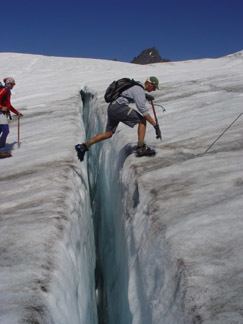 | ||
A crevasse is a deep crack, or fracture, found in an ice sheet or glacier, as opposed to a crevice that forms in rock. Crevasses form as a result of the movement and resulting stress associated with the shear stress generated when two semi-rigid pieces above a plastic substrate have different rates of movement. The resulting intensity of the shear stress causes a breakage along the faces.
Contents
Description
Crevasses often have vertical or near-vertical walls, which can then melt and create seracs, arches, and other ice formations. These walls sometimes expose layers that represent the glacier's stratigraphy. Crevasse size often depends upon the amount of liquid water present in the glacier. A crevasse may be as deep as 45 metres, as wide as 20 metres, and up to several hundred metres long.
A crevasse may be covered, but not necessarily filled, by a snow bridge made of the previous years' accumulation and snow drifts. The result is that crevasses are rendered invisible, and thus potentially lethal to anyone attempting to navigate their way across a glacier. Occasionally a snow bridge over an old crevasse may begin to sag, providing some landscape relief, but this cannot be relied upon. Anyone planning to travel on a glacier should be trained in crevasse rescue.
The presence of water in a crevasse can significantly increase its penetration. Water-filled crevasses may reach the bottom of glaciers or ice sheets and provide a direct hydrologic connection between the surface, where significant summer melting occurs, and the bed of the glacier, where additional water may moisten and lubricate the bed and accelerate ice flow.
